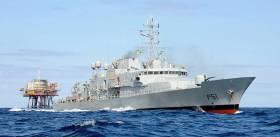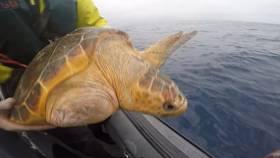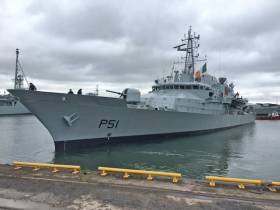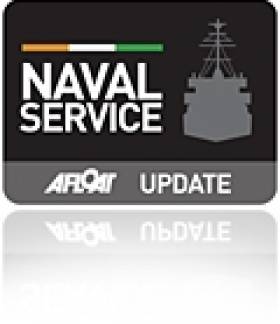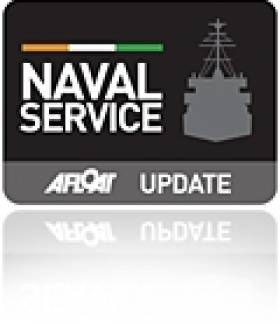Displaying items by tag: LE Roisin
Tributes have been paid to a Naval Service seaman who was found dead on board the patrol ship LÉ Roisín while it was docked in Cork Harbour.
Leading Seaman Conor Kiely (39) was found in an “unresponsive state by crewmates” on board the ship on Friday afternoon, November 17th.
President Michael D Higgins has extended his sympathies to his family and friends, stating, “It is with great sorrow that members of the Naval Service will have heard of the passing of Leading Seaman (L/S) Conor Kiely”.
"L/S Kiely will be remembered by all those with whom he served on a number of the Irish vessels, including the LÉ Aisling, LÉ Niamh, LÉ Orla, LÉ William Butler Yeats and LÉ Róisín," he said.
L/S Kiely was a native of Co Cork and joined the Naval Service in 2006, the Naval Service has said.
He qualified as a seaman gunner in 2007 and “had 17 proud years’ service with the Defence Forces,” it said.
“L/S Conor Kiely served in a number of positions ashore and afloat during his career,” it said.
He had served onboard the LÉ Aisling, LÉ Niamh, LÉ Orla, LÉ William Butler Yeats and most recently as a crew member of LÉ Róisín, and used his experience to instruct in the Naval College, it said.
The Chief of Staff of the Defence Forces, Lieut Gen Seán Clancy, said that on behalf of the Defence Forces, he would “like to express his sincere condolences to the family and friends of L/S Conor Kiely”.
Officer Commanding Naval Operations Command, Captain(NS) Kenneth Minehane, stated; "The members of the Naval Service have sadly lost a shipmate and friend. Our thoughts and prayers go to his family at this sad time. Our dearly departed colleague will be missed and never forgotten.”
LÉ Róisín to Undergo €250,000 Facelift as Equipment Becomes 'Obsolete'
The LÉ Róisín, reports TheJournal.ie, is to undergo a €250,000 facelift as Ireland’s Naval Service works to upgrade its fleet.
The Offshore Patrol Vessel (OPV) was built at Appledore Shipyards in the UK and entered service in 1999.
Since 2016, it has been involved in the rescue of migrants after being deployed to the Mediterranean in 2016 during the European Migrant Crisis.
At the time, the Naval Service vessel carried 60 crew under the command of the ship’s captain Lieutenant Commander Ultan Finegan.
Service life of an Irish Naval Service ship is determined by its level of operational activity - commonly 30 years, a Defence Forces spokesperson told TheJournal.ie which has more on the story here.
LÉ Róisín Open to the Public This August Bank Holiday Weekend at Rathmullan Co. Donegal
#NavalService - L.E. Róisín, leadship of a pair of 'Róisín' or OPV80 class offshore patrol vessels will be open to the public in Co. Donegal this August Bank Holiday weekend.
The OPV is berthed at Rathmullan Pier, Lough Swilly where Naval Service crew yesterday provided guided tours of the 80m OPV. Further tours will be made available between 13:30 - 17:00 today and during tomorrow's Bank Holiday Monday.
Afloat had previously monitored L.É. Róisín during the annual Zeebrugge Navy Days, where foreign navies join those of their host, the Belgian Navy which has a base location within the commercial port that includes a ferry service to Hull in the UK. The three day event took place in late June early July in which public tours of the Irish Naval Service OPV took place.
L.É. Róisín was built by Appledore Shipyards, Bideford in the UK and was commissioned into service in December 1999. The same yard located in north Devon is now under different owners, Babcock Marine which is currently at the final stages of completing the newbuild OPV90 L.É. George Bernard Shaw, an enhanced version of the L.É. Róisín.
As for the construction of L.É. Róisín, Naval Service engineers stood by at all stages of the build.
The OPV80 class was built to a design that optimises patrol performance in Irish waters (which are the roughest in the world), all year round. For that reason a greater length overall (78.8m) was chosen, giving her a long sleek appearance and allowing the opportunity to improve the conditions onboard for her crew.
On board facilities include more private accommodation, a gymnasium and changing /storage areas for boarding teams.
Coast Guard Helicopters Conducting Long Medical Evacuation Assisted by Naval Ship LÉ Roisin
The Shannon based Coast Guard helicopter Rescue 115 has evacuated a seriously injured crewman from a large Russian fishing vessel approximately 140 nautical miles West of Kerry Head.
The operation is being coordinated by the Marine Rescue Coordination Centre in Valentia and is being supported by the Naval ship LÉ Róisín. Crew members from the LÉ Róisín went on board the vessel and assisted with casualty evacuation. Communication support and back up, known as Top Cover was provided by a second Coast Guard helicopter, the Waterford based R117.
Weather conditions in the area for helicopter operations were difficult, bordering on marginal for such operations with a strong West South West swell and winds gusting in excess of 35mph.
The helicopter is currently routing to University Hospital Limerick, to arrive before 7:30pm, following an essential fuel stopover at Kerry airport.
This is the second operation in recent weeks where the LÉ Róisín assisted the Coast Guard in an operation at sea. Coast Guard helicopters are capable of operating out to 200 miles and operations of this nature are indicative of the professionalism of the Coast Guard Helicopter Rescue crews. The Coast Guard complimented the crew of the LÉ Róisín for their efficiency in operating a RIB (Rigid Inflatable Boat) in difficult conditions and for getting crewmembers onto the fishing vessel.
LÉ Roisin responded to a request to provide medical assistance and recover an injured fisherman approx 200 nautical miles off Loop Head. pic.twitter.com/AFmnT3Vl5G
— Irish Defence Forces (@defenceforces) February 21, 2017
Two Operations by LÉ Róisín Rescue Almost 400 Migrants
#SecondSAR - LÉ Róisín successfully searched and rescued (SAR) yesterday 274* migrants from a 18m long wooden vessel craft 39 nautical miles north-west of Tripoli, Libya. The rescue was at the request of the Italian Maritime Co-Oridnation Centre.
Immediately following the first rescue the LÉ Róisín was re-tasked to assist with a further rescue operation of 121* migrants 29 nautical miles north north-west of Tripoli from a 12m long rubber craft.
The rescue commenced at 12.24 pm and all migrants were on board by 2.56pm and are now receiving food, water and medical treatment where required.
Both taskings have now been completed and LÉ Róisín currently has 394 migrants on-board including 78 female.
LÉ Róisín is now transferring the migrants to the port of Catania where they will be administered by the Italian authorities.
*Figures for the operation are provisional until confirmed by the Italian authorities.
The LÉ Róisín departed Naval Service Headquarters in Haulbowline, Cork to assist the Italian Authorities in the humanitarian SAR operations in the Mediterranean. The first such operation began on 11th of May.
#Turtles - Two rescued loggerhead turtles have been returned to the ocean by the crew of LÉ Róisín as the Naval Service vessel makes its way to the Mediterranean on deployment.
According to RTÉ News, the Naval Service were only happy to oblige when contacted by Dingle Oceanworld about the possibility of releasing Una and Tallula.
The former was nursed back to health at the Dingle marine wildlife sanctuary after she was found at Barryroe in West Cork last December.
LÉ Róisín releases rescued turtles while en route to Mediterranean (Vid:Irish Naval Service) https://t.co/yyrasAbj23https://t.co/xJ8iSENsdr
— RTÉ News (@rtenews) May 5, 2016
She was joined on the OPV by Tallula, a turtle washed up in Cornwall who was treated at Newquay's Blue Reef Aquarium and flown into Dingle especially for release.
As previously reported on Afloat.ie, LÉ Róisín and its 57-strong crew are headed to the Mediterranean as the first deployment for the Naval Service this year under Operation PONTUS.
L.É. Róisín Leaves For Latest Mediterranean Mission
#Roisin2Med - LÉ Róisín has departed Naval Base at Haulbowline this afternoon (Sunday 1 May) for Ireland's latest search and rescue mission in the Mediterranean.
As previously reported on Afloat.ie, LÉ Róisín follows last year's humanitarian missions by LÉ Eithne, LÉ Niahm and LÉ Samuel Beckett in the Mediterranean, where between them they rescued more than 8,500 migrants.
The latest mission, in conjunction with Italian authorities, sees a 57-strong crew set sail today for the Mediterranean as the first deployment for the Naval Service this year under Operation PONTUS.
LE Roisin slipping and proceeding from Haulbowline en route to Med Search and Rescue mission this afternoon pic.twitter.com/am5WuDhish
— Irish Defence Forces (@defenceforces) May 1, 2016
It is only in recent years that larger vessels can berth at this stretch of the waterfront following the completion of several major construction projects over the last decade. From the building of the Convention Centre and the Samuel Beckett Bridge which involved using the dredger Hebble Sand (click HERE) during its construction process.
In addition the refurbishment of Spencer Dock sea-lock entrance that for many years was closed is now re-opened. The dock entrance featured in the start of the new television series 'Waterways'-The Royal Canal. Episode two is this Sunday on RTE 1 at 8.30pm.
Aside the 79m L.E. Roisin, the last large vessel to berth close to berth 16A was the French 58m tallship Belem, which was chartered by Alliance Francaise to celebrate their 50th anniversary in 2010 and for the inaugural French Hoist the Sail: Market Festival. The three-masted barque built in 1896 was once also owned by the Sir Arthur Ernest Guinness under the name of Fantôme II.
Situated between where L.E. Roisin is currently berthed and where the Belem had moored, is home to the 'resident' M.V. Cill Airne, a floating bar and restaurant dining venue at berth 16B. Another resident is the former lightship Kittiwake at berth 17B, though sited much further downstream at the end of North Wall Quay, opposite the O2 Arena and next to the East-Link Bridge.
There is a fourth resident, again berthed on the north quays, though the Jeanie Johnston unlike her counterparts is moored closer to the city-centre at Custom House Quay. Apart from yachts, leisure-craft and occasional private motor-yachts using the Dublin City Moorings, she is the only vessel to permanently occupy a berth between Samuel Beckett Bridge and the Sean O'Casey foot-bridge.
- inland waterways
- Dublin Port
- Dublin Docklands
- Royal Canal
- Jeanie Johnston
- naval service
- Custom House Quay
- Alliance Française
- Spencer Dock
- Sean O'Casey Bridge
- River Liffey
- Belem
- Sir John Rogersons Quay
- TallShips
- North Wall Quay
- Fantome II
- Dick Warner
- Dublin City Moorings
- Navy News
- O2 Arena
- EastLink bridge
- LE Roisin
- Sir Arthur Guinness
- National Convention Centre Dublin
- Samual Beckett Bridge
Roisin Returns from Russia
In addition the OPV delivered medical supplies on her visit to Riga, the Latvian capital, where the cargo was transported in aid of the Chernobyl Children's Project based in Belarus.



























